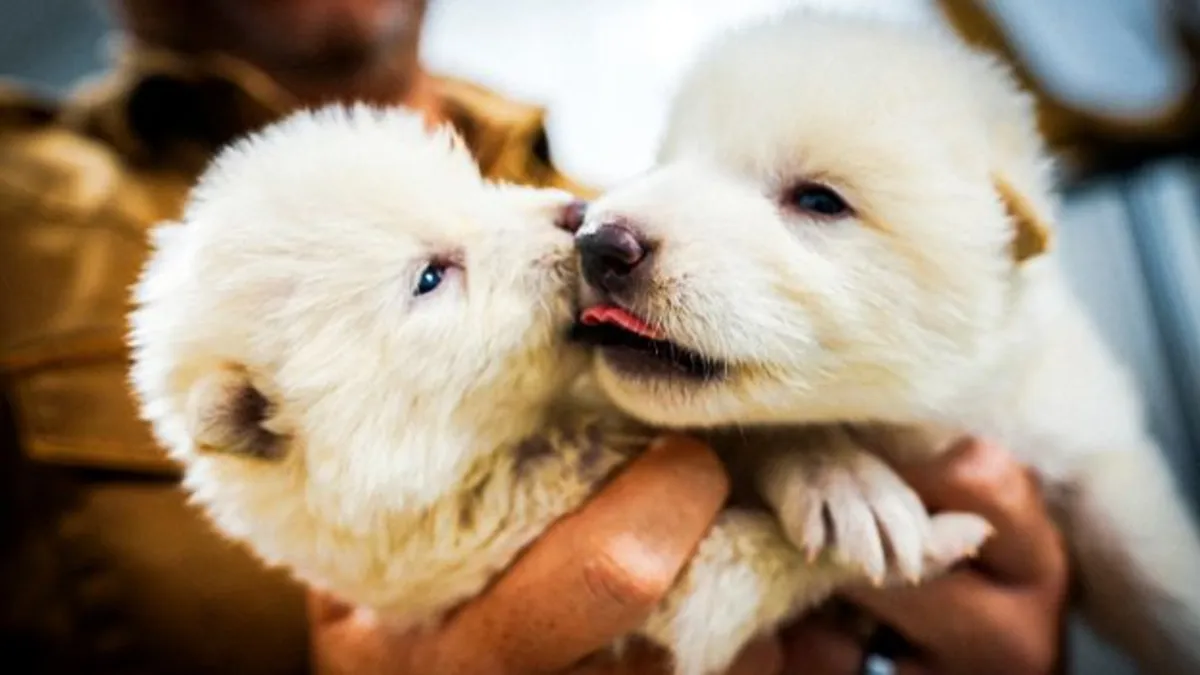
The recent announcement from Colossal Biosciences, a pioneering biotechnology company based in Dallas, has ignited excitement and debate in the scientific community. The company has successfully created three dire wolf pups, raising hopes that the resurrection of extinct animals may be within reach. This species, which last walked the earth approximately 13,000 years ago, has recently gained popularity through its portrayal in the hit series Game of Thrones, which features fictional dire wolves.
The buzz surrounding this development intensified when a photograph surfaced of Game of Thrones author George R. R. Martin holding one of the charming white pups. Martin, an investor in Colossal, expressed his enthusiasm on his blog, stating, "The rebirth of the dire wolf has stirred me as no scientific news has since Neil Armstrong walked on the moon." He also hinted that more extinct species, such as the woolly mammoth, Tasmanian tiger, and dodo, may follow suit.
Colossal Biosciences, currently valued at a staggering $10 billion (£7.6 billion), boasts an impressive lineup of supporters, including celebrities like Chris Hemsworth and Paris Hilton, as well as the CIA. The company boldly claims on its website that it aims to address the extinction crisis by reintroducing lost species back into their historical habitats. According to Matt James, Colossal’s chief animal officer, the vision is not to create a Jurassic Park-like environment but to foster biodiversity and stability in ecosystems affected by human activity.
James explained to the BBC that their focus is on species that can create cascading effects on their ecosystems, potentially aiding in climate change mitigation. Colossal's approach to de-extinction represents the most significant effort to revive long-lost species in modern history. The three newly created dire wolves are, in fact, genetically modified grey wolves that have undergone 20 gene edits to mimic the traits of their extinct counterparts.
Despite the excitement, the scientific community has voiced significant apprehensions regarding Colossal's approach. Many experts argue that efforts to bring back long-extinct species are not only costly but could detract from vital conservation work aimed at protecting currently endangered species. Concerns have been raised that the idea of resurrecting extinct species might create a false sense of security, leading policymakers and industries to believe that environmental damage can be rectified through de-extinction efforts.
David Shiffman, a marine conservation biologist based in Washington, D.C., cautioned that such claims could undermine ongoing conservation efforts, particularly at a time when the U.S. is withdrawing from international climate agreements. He criticized Colossal's optimistic portrayal of its work as a conservation victory, labeling it "beyond irresponsible." This sentiment was echoed by Doug Burgum, the U.S. Secretary of the Interior, who praised Colossal’s work as a potential cornerstone for modern species conservation while criticizing the effectiveness of the endangered species list.
Biodiversity faces numerous threats, primarily driven by human activities. According to the International Union for Conservation of Nature (IUCN), the leading causes of species extinction include habitat destruction, invasive species, overexploitation from fishing and hunting, pollution, and climate change. While Colossal claims that its de-extinction initiatives will directly benefit conservation efforts, experts argue that the company must connect its work to addressing these pressing threats to biodiversity.
Kent Redford, a former director of the Wildlife Conservation Society, emphasized the need for Colossal to demonstrate how its work can mitigate the IUCN's identified threats. Although Colossal promotes the idea that resurrected woolly mammoths could enhance Arctic resilience against climate change, skepticism remains regarding the scientific validity of such claims. For instance, research comparing carbon storage in Arctic ecosystems suggests that tree-covered areas may store significantly more carbon than tundra, raising questions about the actual impact of resurrected mammoths on carbon levels.
As Colossal pushes the boundaries of genetic technology, ethical concerns regarding the treatment of living species, particularly elephants, have emerged. Critics argue that using Asian or African elephants as surrogates for creating woolly mammoth hybrids raises significant ethical questions. Nitin Sekar, a conservation scientist, questioned whether it is ethical to experiment on intelligent and social beings like elephants for the purpose of creating visually appealing animals that do not truly replicate the original species.
Moreover, the costs associated with Colossal's de-extinction efforts are likely in the millions, and experts argue that preventing existing species from going extinct would be far more effective. Many contend that addressing the root causes of extinction is essential, as resurrected species could quickly face the same threats that drove them to extinction in the first place.
While Colossal's work on de-extinction may captivate public interest, many experts believe that the company's genetic technologies can be applied to conservation efforts that address the pressing needs of living species. Julie Meachen, a vertebrate paleontologist, pointed out that the techniques developed by Colossal could prove beneficial for endangered species facing challenges like genetic diversity loss.
Colossal’s commitment to investing in the conservation of endangered species, such as red wolves and elephants, is certainly a step in the right direction. However, experts urge that without addressing the broader environmental issues that threaten these species, the benefits of genetic modifications may be limited. By focusing on innovative solutions that directly combat the factors contributing to extinction, Colossal could play a crucial role in the future of conservation.
In summary, while the resurrection of the dire wolf represents a remarkable scientific achievement, it is essential to maintain a balanced perspective on the ethical, ecological, and practical implications of such endeavors. The quest for conservation must encompass a broader understanding of how technology can be harnessed to protect our planet's biodiversity.